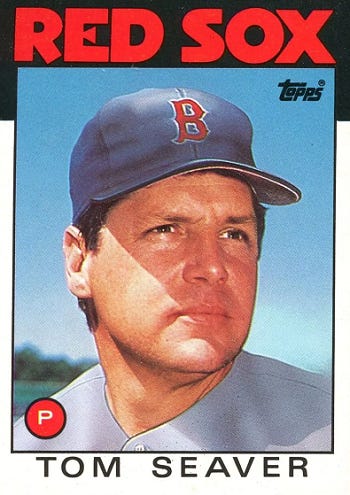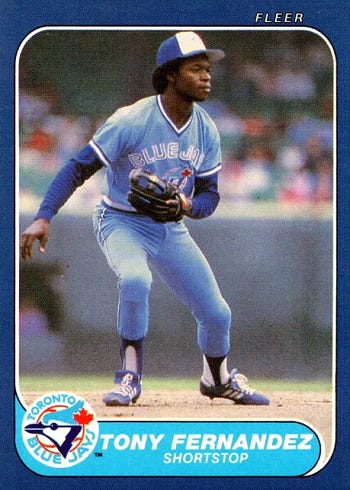5 Baseball Cards Road into the Sunset with Tom Seaver
The "artwork" was reserved for the man himself
The late, great Tom Seaver was born 80 years ago today. To celebrate, I thought we’d take a trip down memory lane, back to Seaver’s very last game…
By September of 1986, Seaver was in the Red Sox’ rotation as they finished off their American League East title run. On the 19th, Seaver started against the Blue Jays in Toronto, opposite Dave Stieb. Seaver pitched a perfect first after Stieb gave up two Boston runs in the top of the frame. Their fortunes reversed in the second before both struggled in the third.
Stieb was perfect again in the fourth, which brought Seaver to the mound for the last time, trailing 3-2.
Here is the story of Tom Terrific’s final moments in major league baseball, told in five baseball cards.
1986 Topps Traded Tom Seaver (#101T)
The Mets righted one of baseball’s long-standing wrongs (though I was OK with the “wrong”) when they brought Seaver back to New York before the 1983 season in a trade with the Reds. Barely a year later, though, the Mets left him unprotected in the free agent compensation draft, and the White Sox swooped in to nab the 39-year-old.
Despite his advanced baseball age, Seaver went 31-22 combined in 1984 and 1985. After a rough start in1986, Chicago traded Seaver to Boston on June 29 in exchange for Steve Lyons. That was early enough for Topps to reserve a spot for Seaver in their year-end Traded set.
And, apparently, early enough to get the airbrush nice and warmed up.
1986 Topps Traded Rick Leach (#63T)
Leach signed with the Blue Jays in 1984 after the juggernaut Tigers released him toward the end of Spring Training. He hit .261 in part-time duty for the Jays that summer, then spent most of 1985 in the minors as Toronto won their first division title. Thanks to that detour to the bushes, Leach didn’t appear in any of the 1986 base sets.
He was back in Toronto in 1986, though, and ended up hitting a robust .309 in 110 games as a pinch hitter, DH, and corner outfielder (with some first-base cameos). On Seaver’s last day, Leach was the starting DH.
He led off the fourth by grounding out to first, where Seaver himself was covering.
Leach returned to steadier big league action just in time to land a spot in the 1986 Topps Traded set, 38 slots ahead of Tom Terrific.
1986 Donruss The Rookies Kelly Gruber (#16)
You had to be there to get the entire historical context, but Donruss created “The Rookies” in 1986 basically to capitalize on the hype surrounding Wally Joyner’s breakout rookie season. Sounds silly today, considering that Joyner didn’t even win the Rookie of the Year Award that season, but his first half power surge had people talking like he was Super Joe Charboneau and Fernando Valenzuela rolled up into one kid-faced ball of awesome.
The happy byproduct of Joyner’s emergence and the scramble to get him on cardboard was that we got some extra sets — The Rookies was the most prominent of those “extras.” And besides Joyner and eventual American League ROY Jose Canseco, Donruss delivered 53 other rookies/prospects/set-fillers.
Gruber was one of those, following two cups of coffee (in 1984 and 1985) and a rookie season spent mostly at third base, with double-digit appearances at second and DH, too. His .196 batting average and five home runs in 87 games didn’t excite many people, but this card would gain some traction a few years later when Gruber developed into a 30-homer man (for one season, at least).
As the third-to-last man to bat against Seaver, Gruber grounded out to second.
1986 Topps Manny Lee (#13)
Lee was just 21 years old when he stepped in against Seaver on September 19, at the end of his second partial season in the majors. He had hit .200 in 1985 and would finish at .205 in 1986, and it took until 1987 for him to finally exhaust his rookie status.
Topps bought into his future as a major league middle infielder enough to grant him a rookie card in their 1986 base set.
As it turned out, Lee would at least partially vindicate Topps’ faith in him by logging parts of eleven seasons in the majors, mostly as a part-timer. Even so, his glove was a strong asset and he improved his batting eye enough to raise his career average to .255 by the time all was said and done in 1995.
He made a case for the viability of his bat on that late summer day back in 1986. With two out and nobody on, Lee tagged Seaver for a line-drive single to left field.
1986 Fleer Tony Fernandez (#57)
By 1986, Fernandez had established himself as the starting shortstop for an up-and-coming team with a bright future. And after hitting .289 in 161 games while flashing a sterling glove in 1985, Fernandez was a big reason for the optimism that surrounded the club.
And things got even better for the young shortstop in 1986, even though the Blue Jays took a few steps backward. Not only did he lead the majors with 687 at-bats in 163 games played, he raised his batting average to .310 and made his first All-Star cut. He also picked up his first Gold Glove when the season was over.
Before the hardware, though, Fernandez came to the plate against Tom Seaver in the bottom of the fourth inning on September 19 with one one and two out.
On Seaver’s last pitch in the major leagues, Fernandez flied out to right field.
—
Sammy Stewart came in to relieve Seaver in the fifth inning, and that was all she wrote for one of the greatest pitching careers the game has ever seen.
Incidentally, Stewart also gave up three runs, and the Sox lost, 6-4. Stieb got the win, Seaver took the loss.
In case you were wondering, the first batter Seaver faced in the majors was Matty Alou of the Pirates in April of 1967. Alou doubled off the rookie…to right field.
So, it may have taken him 19 years, but seems Seaver finally figured out how to get fly balls to right to break his way.
Thanks for reading.
—Adam









Wonderful stuff. Thank you!
Wow, that was fun! Would love to see more of these last game recaps